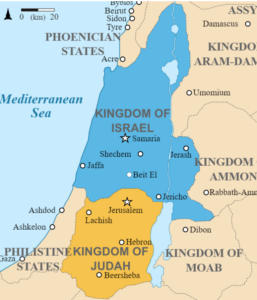An Israelite refers to the ancient people who lived in the land of Israel during biblical times. They were descendants of Jacob, whose name was later changed to Israel (Genesis 32:28), which means “he who strives.” Jew is a term that originally referred to the descendants of Judah. Both Israel and Judah were the children of Jacob, the son of Isaac, the son of Abraham. These are known as the three primary patriarchs in the Old Testament. The phrase “Abraham, Isaac, and Jacob” occurs 15 times in the Bible: Exodus 2:24; 3:16; 6:3, 8; 33:1; Deut. 6:10; 9:5, 27; 29:13; 30:20; 34:4; 2 Kings 13:23; Jer. 33:26; Matthew 8:11; Acts 3:13. The phrase “sons of Israel” occurs 645 times in the NASB Bible, both Old and New Testaments.
The twelve tribes were divided into two kingdoms around 900 to 700 BC after the death of Solomon. To the north was the kingdom of Israel, and to the south of the kingdom of Judah. Ten tribes were in the north, and two were in the South: Judah and Benjamin.
Jacob, whose name was changed to Israel, fathered 12 sons with four different women:
- Leah is the mother of Reuben, Simeon, Levi, Judah, Issachar, and Zebulun.
- Rachel is the mother of Joseph and Benjamin.
- Bilhah is the mother of Dan and Naphtali.
- Zilpah is the mother of Gad and Asher.
Counting the 12 Tribes
There are two ways of counting the 12 tribes of Israel1
- “as those who receive a land inheritance, which excludes Levi but includes Manasseh and Ephraim who each get an inheritance (Josh 13:33; Josh 16–17).
- the 12 sons of Jacob (which includes Joseph, rather than his two sons Manasseh and Ephraim). The tribes of Manasseh and Ephraim are treated as tribes of Joseph (e.g., Josh 16:4). In addition, Manasseh is called a half-tribe (Josh 1:12; 4:12; 12:6), because half of the tribe took an inheritance from the east side of the Jordan River and the other half took territory to the west of the Jordan (Josh 13:1–14, 29–33).”
Barry, John D., David Bomar, Derek R. Brown, Rachel Klippenstein, Douglas Mangum, Carrie Sinclair Wolcott, Lazarus Wentz, Elliot Ritzema, and Wendy Widder, eds. 2016. In The Lexham Bible Dictionary. Bellingham, WA: Lexham Press
Related Articles
References
| 1↑ | Barry, John D., David Bomar, Derek R. Brown, Rachel Klippenstein, Douglas Mangum, Carrie Sinclair Wolcott, Lazarus Wentz, Elliot Ritzema, and Wendy Widder, eds. 2016. In The Lexham Bible Dictionary. Bellingham, WA: Lexham Press. |
|---|






